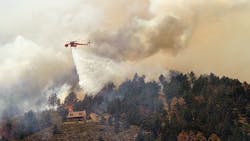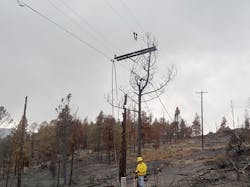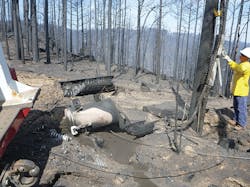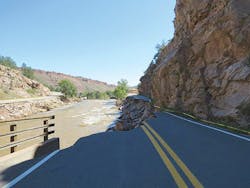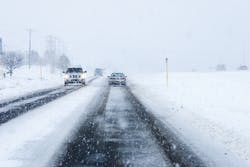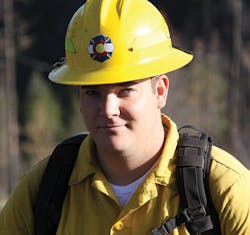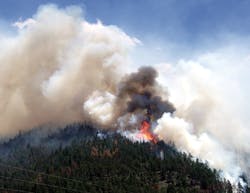Utility Powers Through Fire, Flood and Snow
First, there was fire. Then, there were floods. Today, there is relative tranquility. But, for both the members and employees of the Poudre Valley Rural Electric Association (PVREA), there also are indelible memories of a double-whammy natural disaster that would have tested the mettle of any utility, large or small.
PVREA is a distribution cooperative that serves some 35,000 consumers spread out among 2,000 sq miles of mountainous terrain in northern Colorado. The cooperative’s 89 full-time employees support some 3,600 miles of overhead, underground and transmission line. The region includes the Arapahoe National Recreation Area to the northwest of Denver and Boulder, the Rocky Mountain National Park and the Roosevelt National Forest just a bit farther north; in fact, the region stretches up to the Colorado–Wyoming border in the north.
Mountains, dense forests and deep canyons best describe the terrain — a natural playground for those who love to hike, camp, fish, hunt and enjoy the outdoors. However, in back-to-back summers in 2012 and 2013, this natural playground and its topography was square in the bull’s-eye of historic meteorological events.
Fanning the Flames
Poudre Valley’s tough stretch of weather actually started in the winter and spring of 2011-2012, when the area suffered through a seasonal drought, getting less than 15% of its average seasonal precipitation. By early summer 2012, temperatures already were climbing above 90°F. Thus, by the time a lighting strike set off the High Park fire on June 9, conditions were ripe for the fire to spread — and spread fast.
In the PVREA region, there were at least a dozen named fires that summer, including the Waldo Canyon fire and High Park fire, each of which grew to be among the largest and most destructive fires in the state’s history. Lightning strikes were the most common fire starter, but tinderbox conditions led to at least one fire being started by sparks thrown up from an automobile wheel following a tire blowout. Perhaps most ironically, the Woodland Heights fire in Estes Park was started by a power line rubbing against a pine tree in very high winds.
Bill Unruh, a lineman with 26 years of experience at PVREA who is now a working foreman, was a lead lineman when the fires hit and one of the first responders for the utility. According to Unruh, during the first few days of a fire, all the electric utility can do is de-energize lines at the request of firefighters to make it safe for fire crews to spray water or other flame suppressors on downed lines.
In the case of the High Park fire, within hours, Unruh and others could tell this was a fire the likes of which they had never seen before, based simply on the number of requests to take down lines. “We had to battle a fire or two before, but none near the gravity of this one,” Unruh said.
Next, utilities must wait until fire areas have been cleared by firefighters for re-entry. In the case of the High Park fire, that was complicated by the fact wind conditions kept changing. As the fire burned through one area, it often double-backed with a change of wind direction and burned the area again.
“The High Park fire traveled 25 miles overnight on the first night,” said Terry Willis, who is now retired but in 2012 served as PVREA’s engineering representative supervisor. He oversaw four staff engineers as well as four groups of contract engineers who helped to restore power after the fire. “We had so much wind fanning the flames and such dry conditions,” he recalled.
Furthermore, years of devastation by pine beetles had left many dead trees standing in the area, only adding — quite literally in this case — more fuel to the fire, according to Willis. “The sad thing is this fire was blowing so fast that often it would burn through quickly and then, after a few days, the wind would change and it would blow back on itself,” Willis said. “Everything would get burned again.”
That pattern meant utility crews were kept out for days and up to weeks at a time, as the fire was not considered fully contained until the end of June. When they were allowed into burned-out or contained areas, linemen reported seeing considerable devastation of electric infrastructure.
“Aluminum wire would be gone, poles gone, there might be 6 ft of a charred wood pole still sticking out of the ground,” said Andy Apodaca, a lead lineman with 22 years of experience at PVREA. “Transformers were on the ground, burnt out. Anything plastic was gone. The wire got so hot that there were puddles of aluminum,” Apodaca added.
Service restoration amounted to power customer triage, in a manner of speaking. Willis and his engineering crews tried to determine which circuits were most critical to restore first — dependent, to a large degree, on getting permission to re-enter a burned-out area — and then would work outward from substation to single-phase lines farther out. The job consisted primarily of replacement, not repair, Apodaca noted, as much of the utility’s infrastructure had been damaged beyond repair.
For the duration of the summer of 2012, PVREA held daily meetings at 4:30 p.m., during which field and office employees would update each other on restoration plans and progress. “We would send crews out at daybreak with staking sheets, and they’d come back at 3 p.m. so we could enter the information and plan the next few days,” Willis said. “That also helped us with planning for materials. Communication between management and line workers was really great.”
In all, the High Park fire would burn for almost three full weeks and scorch some 87,000 acres of PVREA’s service territory. The fire destroyed 259 homes and took one life. Some 1,700 electric services were affected, including those shut down to protect firefighters. PVREA suffered more than $2.5 million in damages, lost 390 poles and 14 miles of line. The utility recorded more than 14,000 man-hours of restoration work, not including its office team. Two weeks after the fire was fully contained, PVREA reported that all but 30 active services had been restored.
Next, the Floods
PVREA employees had hardly caught their breath from the 2012 fire restoration when the utility’s service territory was hit with a natural disaster of similar force — though delivered in a completely different medium. This time, water, in the form of epic rainstorms and flash flooding, was the issue. Starting on Sept. 9, 2013, a very slow-moving cold front stalled over much of northern Colorado, mixing with warm, humid air from the south and creating torrential rain that resulted in catastrophic flooding right in the heart of PVREA country.
Boulder County was hardest hit; with an average annual precipitation of 20.7 inches, the county got dumped on with 17.5 inches of rain in just one week, from Sept. 9-15. The other two PVREA counties — Larimer and Weld — fared hardly any better, with 16 inches and 14 inches of rain each, respectively, over just a few days.
Geography, as well as recent history, only added to the deluge. The deep canyons, yawning gulches and steep mountain terrain only added force to raging floodwaters, which spread across nearly 200 miles. At least 1,750 people and 300 pets had to be rescued by air and ground. Some 11,750 people were evacuated, nearly 19,000 homes were damaged and another 1,500 were destroyed.
Some 30 state highway bridges were destroyed and an additional 20 were seriously damaged or submerged. On Sept. 12, Colorado Gov. John Hickenlooper declared a disaster emergency in 14 Colorado counties, including all three counties in PVREA’s service territory. Just as the drought that preceded the fires of 2012 made them burn faster and more furious, land that had just been scorched a year before added force and velocity to the floodwaters.
That is because wildfires clear out trees and forest undergrowth to impede surging water, in addition to leaving the ground almost hydrophobic, or water-repelling. Water that would normally sink into the ground both pools on top and rushes along the surface of a burn scar and, in the case of Colorado’s mountains and valleys, gets a boost from gravity. Canyons become wave machines and gulches become lakes in a matter of minutes. Floodwaters also bring tree limbs, rocks and brush hurtling down the canyons, driving people and animals out while also knocking down power poles, dropping power lines and tearing up roads, bridges and other infrastructure.
To put the flooding in perspective, the National Weather Service rule of thumb is that wildfire burn scar areas are considered susceptible to flash flooding from a 0.5 inch of rainfall. On Sept. 12, Boulder County received 9.08 inches of rain. The destruction had begun.
“Oh, boy, the floods,” recalled Unruh. “It was very dramatic. We had 19 inches of rain in a very short period of time. And you have steep mountains and deep canyons. That is an awful lot of water coming down in one place. I have never seen anything like it.”
As with the Colorado fires of 2012, the 2013 flooding caused tremendous damage to PVREA’s infrastructure and required an all-hands-on-deck mentality to get power restored. In the end, the utility estimates it spent an additional $1.3 million on flood damage repair, had 2,600 services affected, and lost 150 power poles and 160 spans of line, along with numerous meters and transformers as well as damage to other facilities.
That said, PVREA staff note a couple of the more noteworthy contrasts between restoration after a fire and that following a flood.
“Fire goes through and then you go in and fix circuits,” Unruh said. “But the floods made accessibility so tough. Roads and bridges were wiped out, and we could not get our normal construction equipment in anywhere. Everything we did felt like it was on a four- or six-wheeler.”
Apodaca echoes that, commenting on having to follow a pole line straight up a mountain with backhoes and ATVs, as the roads on the base of the mountain had been all washed out.
Ben Ludington is currently a construction supervisor and safety coordinator for PVREA but also has spent five years as a lineman at PVREA and many more years as a lineman in Alaska. He was on duty with PVREA for both the floods and fires, and says another difference is the duration of each event, which, in turn, affects accessibility for restoration work afterward.
“With a flood, you have to wait for the waters to recede,” Ludington notes. “I don’t even know how many poles we lost, but we lost a whole canyon for three months. When bridges get washed out, they can’t be put back up right away. Sometimes we had to drive 15 miles past where wanted to be just to find a road or bridge to get us back there.”
Willis also talked about the “slow motion” of restoring after a flood as compared to a fire. In addition, he points out that, while the fire was concentrated in one county, flood damage stretched across county lines, meaning restoration crews would need to coordinate re-energization of lines with neighboring counties, the U.S. Forest Service and Federal Emergency Management Agency. Another anomaly of flood restoration — at least as compared to fire restoration in Colorado’s mountains — was the communities of customers high up on mountainsides whose structures were relatively unaffected by the floodwaters, but whose services were out because of all the feeder lines coming from lower altitudes.
Finally, and ironically, as if to add one more straw to the figurative camel’s back, in early May 2014, as the story of PVREA’s remarkable restoration efforts was being researched and reported, the PVREA territory got hit with a late spring — Mother’s Day, in fact — snowstorm that dumped more than 2 ft of snow in a period of hours. Apodaca, Ludington and Unruh were among those logging long hours and days endeavoring to maneuver heavy equipment in 2 ft of fresh snow to restore power lost from snow-laden trees downing power lines or vehicles skidding into power poles just off icy roads.
“As a lineman, we are a proud group,” Unruh said. “I always say to my crews, ‘If it was easy, anybody could do it.’ When your power goes out, we get the lights back on. That’s why we’re out here.”
A Hot — Very Hot — Summer Internship
On the afternoon of June 9, 2012, Ryan Nelson had just arrived home to his parents’ house near Fort Collins, Colorado, all set for a summer break after his first year studying at Washington State University. Little did he know, a lightning strike on a bone-dry Colorado mountainside that day would present him with a real-world opportunity that not only complemented his studies but made for an even greater learning experience.
“It was my dad who first pointed out the smoke column to me,” Nelson said of the Colorado wildfire, which had started that morning with a lightning strike in the Colorado mountains west of Fort Collins, rolled down Rist Canyon toward the city, burned for three full weeks — eventually burning more than 87,250 acres — and destroyed some 259 homes. By the time the High Park fire was contained, it had become Colorado’s most destructive fire.
On that June day, Nelson headed straight to the Rist Canyon volunteer fire department and embarked on what became one heck of a summer internship. First up, he was assigned to a crew that went around and alerted residents to the danger of the fast-approaching fire.
“Conditions were set for this fire to explode, and it did,” Nelson recalled. Evacuation orders started at the top of the canyon; on day one, Nelson, fellow volunteers and professional firefighters were on duty until late at night getting people out. By the time Nelson had come back the next morning, the fire had moved 20 miles down the canyon overnight.
“I had never seen a fire like this,” Nelson commented. “It had moved a lot overnight, and it changed directions about every three or four days. The fire was also going downhill, and you don’t expect that. Fires usually burn uphill. But the fuels were so dry, the wind was so strong and the fire was so hot that there was no way to contain it.”
Regarding the electric utility damage of the High Park fire, Nelson noted the main thing firefighters do is try to mitigate their risk around electric wires and poles that are down. “We have to make sure we are in constant communication around anything electrical,” Nelson said. “Among the most important safety steps is to identify wires and poles on the ground and keep everyone away until the utility crews can get there.”
Nelson worked as a volunteer on the High Park fire through September 2012 and decided to transfer to nearby Aims Community College in Greeley, Colorado, to finish his degree. His current plans are to continue to volunteer wherever and whenever he can fighting mountain wildfires, but he also is interested in traveling to different parts of the country and would not rule out urban firefighting, if given the opportunity.
“I would go anywhere and would like to see the rest of the country, having spent most of my time in the West,” Nelson observed. Wherever life takes him, Nelson has no doubt about what he wants to do. “I’ve always known, from an early age, that I wanted to fight fires,” he stated. “I don’t remember exactly how or why that started, but here I am, and it looks like I’m going to end up doing what I want.”
